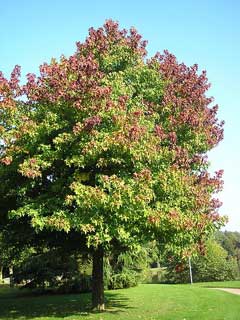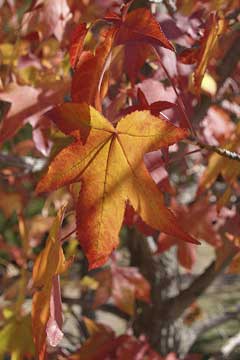 |
|
http://commons.wikimedia.org/wiki/User:Ikmo-ned |
 |
| http://commons.wikimedia.org/wiki/User:Luis_Fern%C3%A1ndez_Garc%C3%ADa |
Translate this page:
Summary
Bloom Color: Green, Yellow. Main Bloom Time: Early spring, Late spring, Mid spring. Form: Oval, Pyramidal.
Physical Characteristics

 Liquidambar styraciflua is a deciduous Tree growing to 25 m (82ft) by 15 m (49ft) at a fast rate.
Liquidambar styraciflua is a deciduous Tree growing to 25 m (82ft) by 15 m (49ft) at a fast rate.
See above for USDA hardiness. It is hardy to UK zone 5 and is not frost tender. It is in flower in May, and the seeds ripen from October to November. The species is monoecious (individual flowers are either male or female, but both sexes can be found on the same plant) and is pollinated by Bees.
Suitable for: light (sandy), medium (loamy) and heavy (clay) soils and prefers well-drained soil. Suitable pH: mildly acid and neutral soils. It cannot grow in the shade. It prefers moist soil.
UK Hardiness Map
US Hardiness Map
Synonyms
Plant Habitats
Woodland Garden Canopy;
Edible Uses
Edible Parts:
Edible Uses: Gum
A chewing gum and a stabilizer for cakes etc is obtained from the resin[102, 105, 149, 159]. It can also be chewed to sweeten the breath[183].
References More on Edible Uses
Medicinal Uses
Plants For A Future can not take any responsibility for any adverse effects from the use of plants. Always seek advice from a professional before using a plant medicinally.
Antiseptic Astringent Carminative Cholera Diuretic Dysentery Expectorant Parasiticide
Poultice Salve Sedative Stimulant Vulnerary
A resin obtained from the trunk of the tree (see 'Uses notes' below) is antiseptic, carminative, diuretic, expectorant, parasiticide, poultice, salve, sedative, stimulant, vulnerary[21, 46, 57, 61, 149, 171, 213, 218, 222, 238]. It is chewed in the treatment of sore throats, coughs, asthma, cystitis, dysentery etc[222, 238, 257]. Externally, it is applied to sores, wounds, piles, ringworm, scabies etc[222, 238]. The resin is an ingredient of 'Friar's Balsam', a commercial preparation based on Styrax benzoin that is used to treat colds and skin problems[238]. The mildly astringent inner bark is used in the treatment of diarrhoea and childhood cholera[222].
References More on Medicinal Uses
The Bookshop: Edible Plant Books
Our Latest books on Perennial Plants For Food Forests and Permaculture Gardens in paperback or digital formats.

Edible Tropical Plants
Food Forest Plants for Hotter Conditions: 250+ Plants For Tropical Food Forests & Permaculture Gardens.
More

Edible Temperate Plants
Plants for Your Food Forest: 500 Plants for Temperate Food Forests & Permaculture Gardens.
More

More Books
PFAF have eight books available in paperback and digital formats. Browse the shop for more information.
Shop Now
Other Uses
Adhesive Gum Incense Parasiticide Resin Teeth Wood
The aromatic resin 'Storax' is obtained from the trunk of this tree[46, 57, 61, 64]. It forms in cavities of the bark and also exudes naturally. It is harvested in autumn[181, 238]. Production can be stimulated by beating the trunk in the spring[171, 238]. The resin has a wide range of uses including medicinal, incense, perfumery, soap and as an adhesive[149]. It is also chewed and used as a tooth cleaner[183]. Wood - heavy, fairly hard, fine-grained, not strong, light, tough, resilient. It weighs about 37lb per cubic foot[227]. The wood takes a high polish and can be stained then used as a cherry, mahogany or walnut substitute[171]. It is also used for furniture, flooring, fruit dishes, veneer etc[46, 61, 82, 149, 227].
Special Uses
Food Forest Scented Plants
References More on Other Uses
Cultivation details
Landscape Uses:Aggressive surface roots possible, Specimen, Street tree. Prefers a moist but not swampy loam in a sunny sheltered position[11, 200]. Succeeds in light shade[188]. Prefers a neutral to acid soil[130]. Plants grow poorly in shallow soils overlying chalk[188]. Young plants are susceptible to damage from late frosts. A highly ornamental plant, especially in its autumn foliage[1, 227], it grows well in Cornwall[59] and S. England but does not do well in the north[98]. A fast-growing and long lived tree, it is fairly free from pests and diseases and has the potential to be a re-afforestation tree in cutover lands[227]. Trees commence flowering when about 20 - 25 years old[229]. The leaves emit a balsam-like fragrance when they fall in the autumn, this is retained until the leaves are quite withered[245]. Plants in the north of their range do not produce much resin[183]. Resists honey fungus[88]. This species resents root disturbance, young plants should be pot-grown and be placed in their permanent positions as soon as possible[200]. Special Features:Attractive foliage, North American native, Invasive, Naturalizing, Inconspicuous flowers or blooms. In garden design, as well as the above-ground architecture of a plant, root structure considerations help in choosing plants that work together for their optimal soil requirements including nutrients and water. The root pattern is flat with shallow roots spreading near the soil surface [2-1].
References Carbon Farming Information and Carbon Sequestration Information
Temperature Converter
Type a value in the Celsius field to convert the value to Fahrenheit:
Fahrenheit:
The PFAF Bookshop
Plants For A Future have a number of books available in paperback and digital form. Book titles include Edible Plants, Edible Perennials, Edible Trees,Edible Shrubs, Woodland Gardening, and Temperate Food Forest Plants. Our new book is Food Forest Plants For Hotter Conditions (Tropical and Sub-Tropical).
Shop Now
Plant Propagation
Seed - best sown as soon as it is ripe in the autumn in a cold frame. Harvest the seed capsules at the end of October or November, dry in a warm place and extract the seed by shaking the capsule. Stored seed requires 1 - 3 months stratification and sometimes takes 2 years to germinate. Sow it as early in the year as possible. Germination rates are often poor. Prick out the seedlings into individual pots when they are large enough to handle and grow them on in a cold frame or greenhouse for their first winter. Since they resent root disturbance, it is best to plant them out into their permanent positions in early summer of their second year and give them some protection from cold for their first winter outdoors[K]. Cuttings of half-ripe wood, July/August in a frame. Suckers in early spring. Layering in October/November. Takes 12 months.
Other Names
If available other names are mentioned here
Native Range
NORTHERN AMERICA: Canada (Québec, Nova Scotia, Prince Edward Island, New Brunswick, Newfoundland and Labrador), United States (Connecticut, Maine, Massachusetts, New Hampshire, New Jersey, New York, Rhode Island, Alabama, Delaware, Florida, Georgia, Louisiana, Maryland, Mississippi, North Carolina, South Carolina, Virginia, Texas), Mexico (Tamaulipas). SOUTHERN AMERICA: Belize, Guatemala, Honduras, Nicaragua, El Salvador
Weed Potential
Right plant wrong place. We are currently updating this section.
Please note that a plant may be invasive in one area but may not in your area so it's worth checking.
Conservation Status
IUCN Red List of Threatened Plants Status :

Growth: S = slow M = medium F = fast. Soil: L = light (sandy) M = medium H = heavy (clay). pH: A = acid N = neutral B = basic (alkaline). Shade: F = full shade S = semi-shade N = no shade. Moisture: D = dry M = Moist We = wet Wa = water.
Now available:
Food Forest Plants for Mediterranean Conditions
350+ Perennial Plants For Mediterranean and Drier Food Forests and Permaculture Gardens.
[Paperback and eBook]
This is the third in Plants For A Future's series of plant guides for food forests tailored to
specific climate zones. Following volumes on temperate and tropical ecosystems, this book focuses
on species suited to Mediterranean conditions—regions with hot, dry summers and cool, wet winters,
often facing the added challenge of climate change.
Read More
Expert comment
Author
L.
Botanical References
1143200
Links / References
For a list of references used on this page please go here
Readers comment